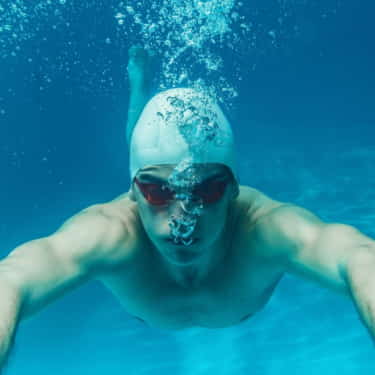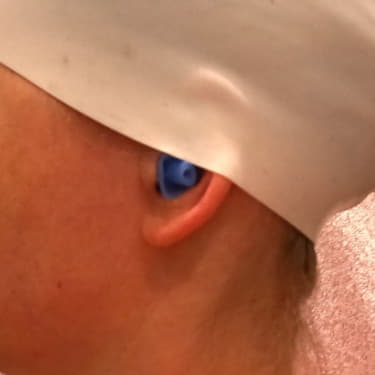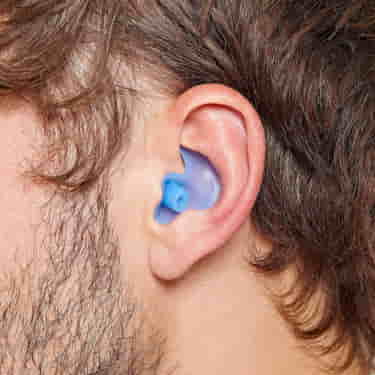Swim ear plugs have become an essential part of my swim kit in recent years after suffering from swimmer’s ear (an infection in the outer ear canal).
As a general rule, a well-fitted pair of swim ear plugs will feel comfortable, stay in place while swimming, and work well by preventing excess water from entering the ear.
In this article I will investigate:
- Do swim ear plugs work?
- Do you need swimming ear plugs?
- What is swimmer’s ear and how to prevent it?
- What are the different types of swim ear plugs?
- How to fit swim ear plugs
- How to care for swim ear plugs
- How to stop swimming ear plugs falling out.

The biggest concerns about swim ear plugs for swimmers are:
- Will they be comfortable or irritating when swimming?
- Will they fall out mid-swim?
After a terrible ear infection because of swimming, I have paid extra special attention to my ears. In addition, I am also a musician and often work with loud sounds, so I am protective of my ears.
For many swimmers, swim ear plugs are an afterthought or something to be investigated after an incident such as an ear infection.
Prevention is better than cure, however, so if you have not already considered wearing swim ear plugs, they are certainly worth considering if you are a regular swimmer.
Do You Need Swim Ear Plugs?
As a general rule, if you swim regularly or have ears susceptible to ear infections, then you should consider using ear plugs.
Swim ear plugs are often considered essential for regular child swimmers, as their smaller ear canals can retain water, and more ear infections occur as a result. However, a lot of adults are also susceptible to ear infections.
If water getting into your ear is a problem, then you need to wear ear plugs while you swim.
What Is Swimmer’s Ear?
Swimmer’s ear is caused by trapped water inside the ear, which if not removed, will allow bacteria to grow and, as a result, an ear infection will occur.
Typical mild symptoms of swimmer’s ear include:
- Itching
- Slight Redness
- Discomfort in the Ear
If left untreated, swimmer’s ear will worsen, and it is recommended to see your doctor even if you have mild symptoms.
How To Prevent Swimmer’s Ear?
I have experienced swimmer’s ear, and it is not pleasant. Also, after experiencing swimmer’s ear, you realise how delicate our ears are and that we should protect well them during and after swimming.
As a general rule, to reduce the risk of swimmer’s ear, keep your ears as dry as possible. After your swim, ensure you remove all water from your ears and ensure they are as dry as possible.
While swimming, you can wear a swim cap over your ears and swim ear plugs to prevent excess water from entering the ear.
To learn more information about swimmer’s ear and how to prevent it, here is a full informational PDF from the U.S Department of Health and Human Services.
What Are The Different Types Of Swim Ear Plugs?
There are many swim ear plugs on the market with different shapes, sizes and advantages. Here are the swim ear plugs that are seen most often.
1 – Silicone Swim Ear Plugs
By far, the most popular ear plugs for swimming are silicone which is soft and can be washed easily.
If you get a pair of silicone swim ear plugs you like, you can get a lot of mileage out of them if you wash them frequently and keep them in a protective case.
We typically find these silicone ear plugs in two main styles, which are shown below.
Silicone Swim Ear Plugs – “Spear Head Design”

This “spearhead” design swim ear plugs are very popular, however, my biggest complaint about this design is that they never stay in (well, in my ears anyway!)
Typically, these swim ear plugs are attached to each other with a chord, so when they fall out, they will not just float away and get lost. From my experience, they repeatedly fall out unless you are lucky enough to just have the right ear profile for this ear plug shape.
This type of silicone ear plug is typically the cheapest type on the market and can be reused, which is one of the reasons why they are so popular with swimmers as they are relatively cheap to replace.
Silicone Swim Ear Plugs – “Ergo Design“

Personally, these are one of my favourite types of silicone swim ear plugs.
Easy to clean, store and use long-term, the ergo design is comfortable and soft on the ears.
My favourite aspect of this design is the extra “lip” which acts as a guard for the full ear canal.
The hidden advantage of this shape is that I can tuck this lip nicely underneath my swimming cap, making these feel secure and giving me confidence that they will stay in place.
2 – Silicone Moldable Ear Plugs
Also known as silicone putty ear plugs, these ear plugs are basically little lumps of silicone that you can mould to block your ear.

The big advantage of this type of swim ear plugs is that the ear plug can be custom moulded to your ear. You just mould and form the silicone-like putty until you have a good fit.
With this type of ear plug, your ear canal will be completely blocked so no water will enter your ear.
Given the custom self-made and affordable fit, this is a very popular design and very affordable.
Some disadvantages of this type of silicone swim earplug are:
- Your ear canal is fully blocked, which might give the feeling of pressure inside the ear.
- Some manufactures provide tiny balls of silicone, which feel “too small” to be placed in the ear. Therefore, stick to leading brands such as Mack’s Pillow Soft Silicone Putty Ear Plugs, which is endorsed by USA Swimming.
3 – Custom Molded Swim Ear Plugs
As the name suggests, these are swim ear plugs that are custom-fitted to your ear.
Today, they can make a 3D scan of your ear and a “perfectly molded” pair of ear plugs are produced.
These will be 100% custom fit to your ears only.
The big disadvantage of custom moulded swim ear plugs is the cost, as this is a real bespoke solution.
Before going down this expensive and custom route, I would recommend trying the silicone moulded ear plugs, Mack’s Pillow Soft Silicone Putty Ear Plugs, which is endorsed by USA Swimming.
This will give you a near-perfect fit and help you experience what wearing silicone ear plugs are like before forking out the big cash.
4 – Foam Ear Plugs [Avoid For Swimming]
Foam ear plugs are great for sleeping but terrible for water, as they are not waterproof.
Avoid wearing foam ear plugs near water as they will absorb water and will pull water into your ear. This is the opposite of what you want.
How To Use Ear Plugs For Swimming
We all have different ear shapes and sizes, therefore, swim ear plugs also come in a range of sizes and types to accommodate a wide variety of ear shapes.
The golden rule on how to fit and use swim ear plugs is to ensure you pick a pair that is comfortable and won’t fall out.
How To Fit Swim Ear Plugs
- First, you need to find a size and shape that works for you. Unfortunately, there is no science behind this and some trial and error might be needed.
- Carefully fit the ear plugs as per the manufacturer’s instructions.
- Fit your swimming cap, and ensure the swim ear plugs are comfortable and snug when your swim cap is fitted.
- Gently shake your head from side to side to ensure the swim ear plugs are securely fitted and won’t fall out.
Caring For Swim Ear Plugs
- After your swim, carefully remove your ear plugs, taking care not to squash or deform them.
- Rinse your ear plugs in warm water.
- Replace your ear plugs in their storage box and allow to dry.
Some of the better quality swim ear plugs will come with their own carry case for easy storage and will maintain the shape of the molded ear plug.
For the best hygiene practice, it is important to keep your swim ear plugs clean and well stored to ensure they do not get dirty.
How To Stop Swimming Ear Plugs Falling Out
One of the biggest concerns for many swimmers when wearing ear plugs is the fear that they will drop out. Therefore, it is recommended to wear a swimming hat over your ears to help to keep the ear plugs in place.
Personally, I hate having my swimming cap completely covering my ears as the build-up of pressure on my ears when under the swim cap is too uncomfortable.
Plus, when swimming in public, I like to hear so I can communicate with other swimmers or hear the lifeguard’s whistle if needed.
I have found a brilliant solution to keep my swim ear plugs in place without blocking my ears with a swimming cap. I wear the following pair of swim ear plugs from Zoggs, which have an extra “lip” that fits into the upper part of the ear.
Here is an image of how this type of ear plug should be fitted. The “lip” at the top of the ear plug, which fits into the upper part of the ear, is a great feature to help these ear plugs stay in place.
I pull my swim cap just over the top of my ears, which traps this upper lip of the ear plug in place. Therefore, if the ear plug does become dislodged in my ear, it will not float away as it is partly trapped by the swim cap.
Here is an image of how I keep my ear plugs in place:

There is a lot of debate in the swimming world about whether your swimming cap should cover your ears. I go into a lot more detail on the issue in my article:
Final Thoughts
I avoided swim ear plugs for years until I got one terrible ear infection from a not so nice pool. Ever since, I have taken extra special care of my ears while swimming.
Ear plugs work by keeping the inner ear canal relatively dry and less exposed to saturation.
Personally, one of the best techniques I have discovered to protect my ears is to ensure they are completely dry after swimming.
Straight after my swim, I will tilt my head from side to side to ensure I leave no water in my ears, as prevention is better than cure.
By using a combination of ear plugs while swimming to prevent extra ingress of water and debris to the ear, and a good after swim ear care routine to ensure my ears are completely dry, my ears have remained in good shape.


